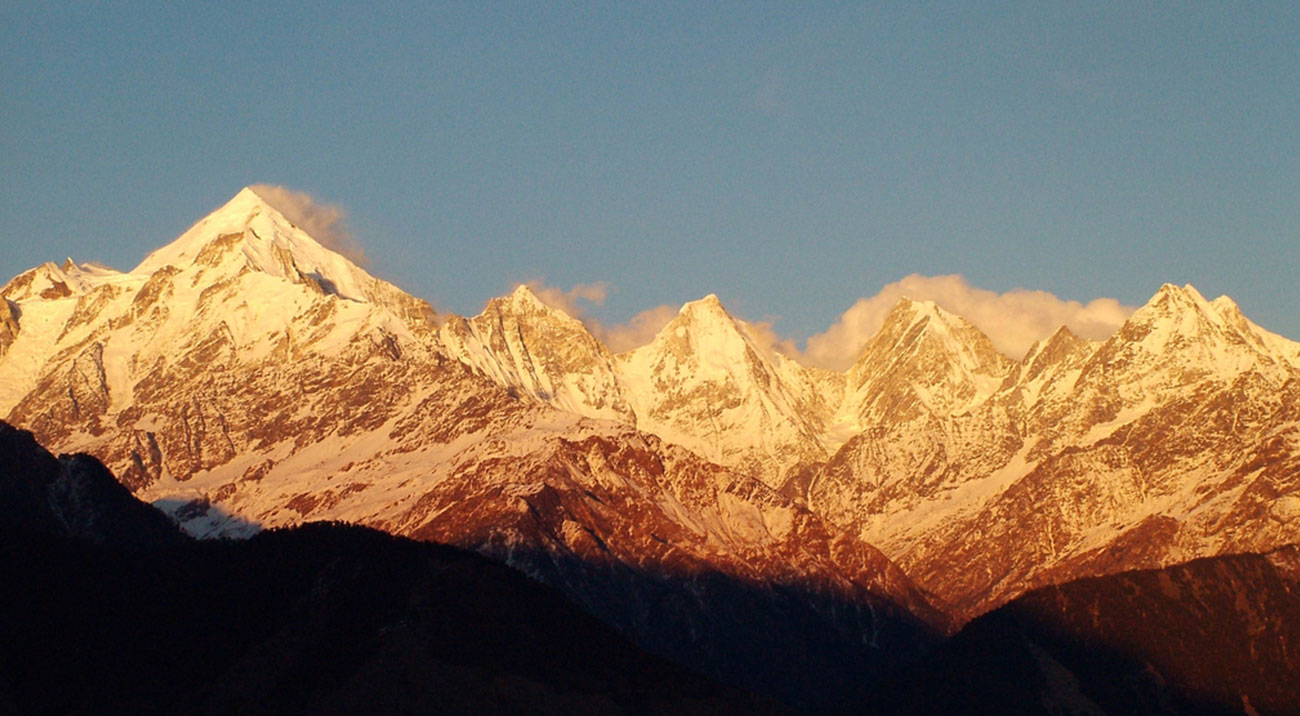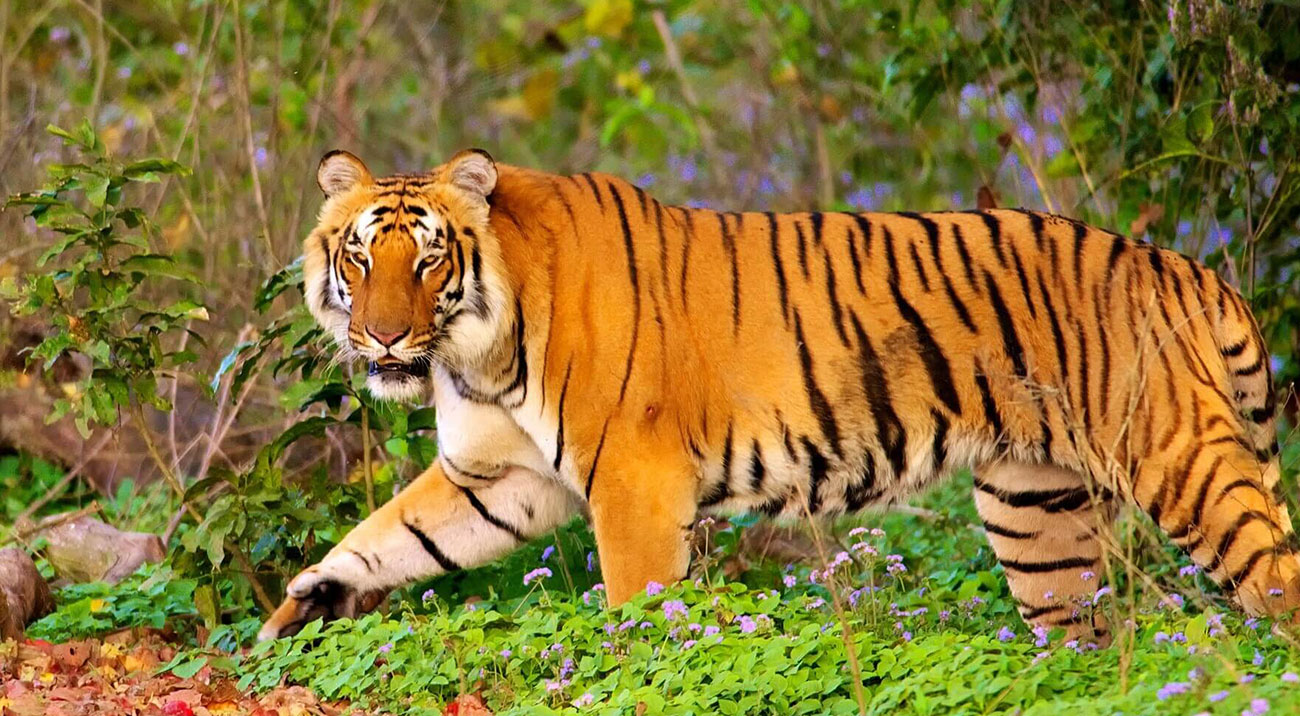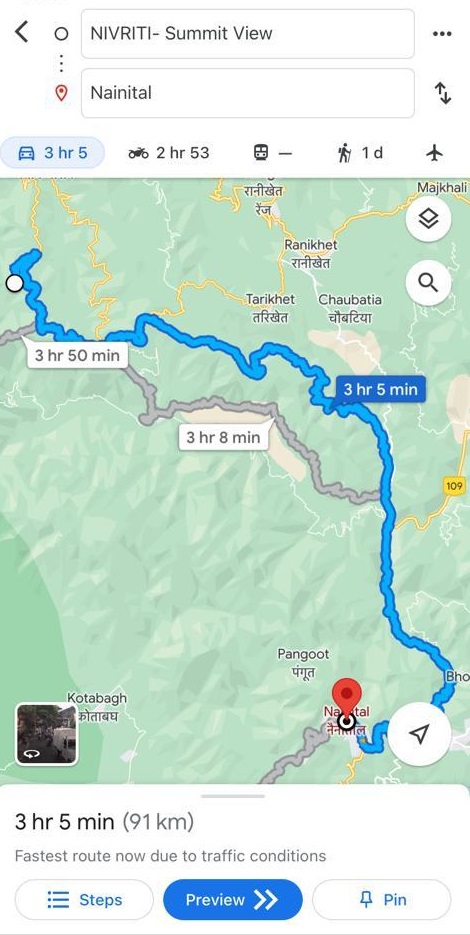Attractions
The highlight of this location is the infinite views of at least 50 snowcapped mountain peaks, with heights ranging from 21,000 to 25,560 feet, visible from the house. You can easily see all the popular hidden gems. The summits of the Himalayan Mountain range are truly majestic in their breathtaking beauty.
Delhi (Central) – Nivriti Summit View : 315 kms
Corbett Dhikala Zone – Nivriti Summit View : 45 kms
Ranikhet – Nivriti Summit View : 44 kms
Nanital – Nivriti Summit View : 89 kms
Almora – Nivriti Summit View : 93 kms
Ramnagar Railway Station – Nivriti Summit View : 65 kms | Pantnagar Airport – Nivriti Summit View : 144 kms

Nanda Devi is the second-highest mountain in India, after Kangchenjunga, and the highest located entirely within the country. It is the 23rd-highest peak in the world. Nanda Devi was considered the highest mountain in the world before computations in 1808 proved Dhaulagiri to be higher. Its name means Bliss-Giving Goddess. The Peak is regarded as the Patron goddess of the Uttarakhand Himalayas.
Trisul is a group of three Himalayan mountain peaks of western Kumaun, Uttarakhand. The three peaks resemble a trident – in Sanskrit, Trishula, trident, is the weapon of Shiva. Beautiful views of these peaks can be seen at Sunrise and Sunset almost daily and especially in our winter months and the monsoon period after the rains.


The Panchachuli peaks are a group of five snow-capped Himalayan peaks lying at the end of the eastern Kumaon region, near the Dugtu village in Darma valley. The peaks have altitudes ranging from 6,334 metres (20,781 ft) to 6,904 metres (22,651 ft). They form the watershed between the Gori and the Darmaganga valleys. Panchchuli is also located on the Gori Ganga-Lassar Yankti divide.
Almora is famous for its wildlife, culture and cuisines. The best season to visit Almora is the summer and the onset of winter. Almora is believed to have gotten its name from Kilmora, a kind of sorrel, a short plant commonly found here, which was said to be used for washing the utensils of the sun temple at Katarmal. Situated on a 5-km-long ridge at the southern edge on the Kashyap hills in the shape of a horse saddle, Almora is a picturesque town set against the backdrop of the snow-capped Himalayas. Once the capital of the Chand dynasty rulers.

Almora is known for its rich cultural heritage, unique handicraft and delicious cuisines. Almora has attracted several eminent people through the ages, including Swami Vivekananda, Rabindranath Tagore, Uday Shankar and his troupe, including Guru Dutt and Zora Sehgal came here for a performance, and Ravi Shankar, who contributed to the cultural enrichment of the town. Govind Ballabh Pant, noted freedom fighter, first chief minister of Uttar Pradesh and later Home Minister of India, was born in Almora. Sir Ronald Ross, who received the Nobel Prize for Physiology (or Medicine) for his path-breaking discovery of the malaria parasite, was born here in 1857. The town also serves as the starting point for many treks like Jageshwar, Pindari, Mornaula, Mukteshwar, Binsar, and Ranikhet among others.
WHEN TO VISIT
The best time to visit Almora is from March to May and mid-September to December.

The Ranikhet Golf Course, located at Upat Kalika is one of the highest golf courses of Asia.[23] It is situated at a distance of 5 kilometres from main Ranikhet City. Ranikhet Golf Course is a 9-hole course making it one of the prime attractions of Ranikhet. The green meadow of the golf course at such high altitude is awe-inspiring. The golf club provides membership plans for outsiders as well.
Ranikhet
Once upon a time, there was a proposal to designate Ranikhet as the summer headquarters of British India, a title which was accorded to Shimla. Ranikhet carries centuries old imperial and colonial legacy and the beautiful garrison town is a land of many brave men like General Kashi Nath Adhikari. Today it’s the headquarters of the Kumaon Regiment. A legend says that a Kumaoni queen was enchanted by this tiny hill paradise and it’s in her honour that a palace was built here, thus the name, ‘queen’s land’ . While no trace of the palace can be found today, but Ranikhet remains the same: captivating, abounding with flowers, trees and green meadows in the midst of heavenly Himalayan surroundings. Interestingly, the nine-hole Ranikhet Golf Course is one of the highest in Asia and the rolling meadows of the course are breathtaking. The place draws several celebrities, who prefer its quiet environs, including actor Rajinikanth. The Tamil film industry’s superstar is a regular visitor to Ranikhet, where he stops on his way to Dunagiri hills (around 45 km away) while visiting the sage Maha Avtar Baba’s meditation cave.
Mankameshwar Temple is a notable attraction of Ranikhet, the temple has been built by Kumaon Regiment. It is located in front of Gurudwara and Shawl Factory. Inside the temple, one can see the idols of Radha-Krishna, Ma Kalika and Lord Shiva.
Ranikhet provides magnificent view of the Chaukhamba, Kedarnath, Kamet, Hathi Parvat and Panchchuli peaks.
Its popular attractions include 400 years old temples of Jhula Devi and Kali Devi ka Mandir. You can also check out Kumaon Regimental Centre Museum and Memorial. Ranikhet is filled with a wide variety of activities that have made it a popular adventure tourist destination.
Nainital, the charming Himalayan lake town, is a picture-postcard perfect hill-station and one of the most popular in Northern India. Commonly known as the ‘Lake District’, Nainital is nestled high up in the Kumaon Himalayas at an altitude of around 2,000 m above sea level. This beautiful town in surrounded by seven hills, popularly known as ‘Sapta-Shring’ – Ayarpata, Deopata, Handi-Bandi, Naina, Alma, Lariya-Kanta and Sher-Ka-Danda. The majestic mountains and the sparkling waters of the lake add an immense lot to the beauty of the town. The town is centred around the emerald mountain lake Naini, which on most days is dotted with colourful sailboats. According to mythology, the lake is believed to have been formed when the eyes of goddess “Sati” fell at this spot while her body was being carried by Lord Shiva after her death.

The summer capital of the United Provinces during the British era, the town has a strong colonial heritage with vibrant clusters of villas and bungalows. Homesick Britishers used to flock to this quaint town spread over a forested valley. It is also known for the revered Naina Devi temple, which stands on the edge of the lake. Nainital is not only a famous tourist destination but is also known for its prestigious educational institutions and schools, which have stood since the British era.
There are many renowned personalities who are either born here or have been associated with Nainital. Jim Corbett, author, and conservationist, was born in Nainital and was also educated here. Jim Corbett National Park in the vicinity is named after him, which is also the first National Park of India. Anoop Jalota, a popular classical singer and cricketer Manish Pandey were born in Nainital. Major Somnath Sharma, India’s first Param Vir Chakra awardee as well as legendary actor Amitabh Bachchan were educated at Sherwood College of Nainital.
Today, Nainital offers everything that’s required for a perfect holiday. Plenty of hotels and resorts are set on the hillside; the Mall Road is a busy shopping hub; cafes and restaurants serve both local and global cuisine and there are innumerable forested trails that offer stunning views of the surrounding landscape. You can paddle in the lake or even try riding a horse in the town. Nainital is also a popular hot-air ballooning and mountaineering.
Places of interest in Nanital
Nainital Lake, Naina Peak, The Mall Road, Tiffin Top, High Altitude Zoo, Lands End, Bhimtal Lake, Kilbury Bird Sanctuary, Kainchi Dham, Naukuchiatal and many more.

Jim Corbett National Park is a national park in India located in the Nainital district of Uttarakhand state. The first national park in India, it was established in 1936 and in 1956, nearly a decade after India’s independence, it was renamed Corbett National Park after the hunter and naturalist Jim Corbett, who had played a leading role in its establishment and had died the year before. The park was the first to come under the Project Tiger initiative.
Corbett National Park comprises 520.8 km2 (201.1 sq mi) area of hills, riverine belts, marshy depressions, grasslands and a large lake. The elevation ranges from 1,300 to 4,000 ft (400 to 1,220 m). Winter nights are cold but the days are bright and sunny. It rains from July to September. The park has sub-Himalayan belt geographical and ecological characteristics.[3] Dense moist deciduous forest mainly consists of sal, haldu, peepal, rohini and mango trees. Forest covers almost 73% of the park, while 10% of the area consists of grasslands. It houses around 110 tree species, 50 species of mammals, 580 bird species and 25 reptile species.
The reserve was renamed in 1954–55 as Ramganga National Park and was again renamed in 1955–56 as Corbett National Park, after author and naturalist Jim Corbett.
The park fared well during the 1930s under an elected administration. Over time, the area in the reserve was increased—797.72 km2 (308.00 sq mi) were added in 1991 as a buffer zone to the Corbett Tiger Reserve.[10] The 1991 addition included the entire Kalagarh forest division, assimilating the 301.18 km2 (116.29 sq mi) area of Sonanadi Wildlife Sanctuary as a part of the Kalagarh division.[10] It was chosen in 1974 as the location for launching the Project Tiger wildlife conservation project. The reserve is administered from its headquarters in the Nainital district.
Corbett National Park is one of the thirteen protected areas covered by the World Wide Fund For Nature under their Terai Arc Landscape Program.[13] The program aims to protect three of the five terrestrial flagship species, the tiger, the Asian elephant and the great one-horned rhinoceros, by restoring corridors of forest to link 13 protected areas of Nepal and India, to enable wildlife migration.
The present area of the reserve is 1,318.54 square kilometres (509.09 sq mi) including 520 square kilometres (200 sq mi) of core area and 797.72 square kilometres (308.00 sq mi) of buffer area. The core area forms the Jim Corbett National Park while the buffer contains reserve forests (496.54 square kilometres (191.72 sq mi)) as well as the Sonanadi Wildlife Sanctuary (301.18 square kilometres (116.29 sq mi)
Today Corbett National Park has over 100 Hotels for Tourists to stay in and these range from Homestays to 5 star Hotels.
Visitors can enter the park through seven entry gates.
The park is divided into six ecotourism zones for the ease of tourists. The safari zone is divided into Seven zones:
1: Dhikala / 2: Bijrani / 3: Jhirna / 4: Dhela / 5: Durgadevi / 6: Sonanadi / 7: Garjiya Tourism Zone. All Park entries’ require Pre obtained entry permits. Dhikala and Durgadevi are the gates closest to Nivriti – Summit view for day excursions or enroute trips coming from and going to Delhi.
Dhikala Zone
The Dhikala Safari zone reopen from 15th of November every year, Durga Devi and Bijrani Zone from 15th of October where as Jhirna and Dhela remains open through the year The Bijrani safari zones are famous for its grasslands. The safaris are a great source of entertainment and they help us learn about the different animals and their habitats. For the convenience of visitors and streamlining tourism management Corbett Tiger Reserve has been divided into six mutually exclusive tourism zones, each having separate gate for entry.
Visitor Season 15 September to 30 June
Jhirna Zone
Jhirna tourist zone in corbett national park is situated at 16 km. from Ramnagar. This area is full of natural beauty and specially known for its wild bear which suddenly appears from nowhere near your vehicle. Limited number vehicles are allowed to get into this area in the morning and same number is allowed in the evening. For morning trips, day visit permit is released in advance which comes into effect for six days before the actual day of the trip. For evening trips, first come first serve system is followed. This is the only tourist zone in Corbett National Park which is open for all 12 months. It’s compulsory to take a guide along. Jhirna has a forest lodge which has two rooms.
Visitor Season Round the year
Durgadevi Zone
Durgadevi tourist zone in corbett national park is farthest from Ramnagar at 28 km. This zone is a hilly area and is situated along the banks of Ramganga River. Besides looking at wildlife, you can also look at popular Mahasheer fish in the river waters. On your way you can halt at Dhangarhi museum. For the day visit, same rules are applicable here as those for Bijrani and Jhirna.
Visitor Season 15 November to 15 June
Bijrani Zone
Bijrani tourist zone in corbett national park is the first choice among day tourists. Its entrance is at Aamdanda which is about 1 km. away from Ramnagar. After entering through Aamdanda gate, you cross about 5 km. of buffer zone before reaching Bijrani and jungle safari starts from this point.
Bijrani is a beautiful spot and is known for its vast grass lands, deep forest , stormy drains and wild life. Limited vehicles are allowed to travel into Bijrani during morning and same number of vehicles is allowed in the evening hours. For morning safari advance booking is required and for evening safari, permits are given on first come first serve basis. Bijrani has a forest lodge which has six rooms and a dormitory.
Visitor Season 15 October to 30 June
Dhangari Gate (For Dhikala Entry)
Dhikala is the biggest forest zone in the corbett national park and you enter this zone via Dhangarhi gate. You have to show your permit at the entrance gate and once it is checked then only you are authorized to enter the park. Once you are through the Dhangarhi gate, your corbett safari is on. Only those who have permit to stay overnight in the park are allowed to take the safari. You can stay for night in the park from one to three nights. It takes about one to one and half hour to reach forest lodge inside the park. On the way you will encounter dense Sal forests, look at Ramganga river and will across many monsoon-drenched drains.
Visitor Season 15th November to 15 June
Dhela Zone :
Dhela zone is famous for its wealthy flora and fauna. It has mixed forests such as Saal, Rohini, Bahera, Haldu, Jamun, Kusum etc. The main wild animals of this zone are Tiger, Leopard, Asiatic Elephant, and Sloth Bears, Barking Deer, Chital Deer, Sambhar Dear, Wild Boar, Langoor and many others. More than 10 species of reptiles and around 400 species of birds are found inside this zone.
Visitor Season Round the year
Garjiya Tourism Zone :
Garjia Tourist Zone is a very popular area of the spectacular Corbett Tiger Reserve. This zone is enriched with a huge number of floral and faunal species. Garjiya gives a tough competition to the Dhikala zone while the tourist’s preferences are concerned. The zone is known for its wonderful landscape and is very calm and quite place. The beauty of this place is appreciated by all the visitors. This is one of the most tiger rich areas of the park. Birjani consists of a mixed topography with dense Sal forests combined with grasslands.
Safari In Garjia
Garjia safari zone is highly endowed with rich diversity of flora and fauna. Garjia zone, situated at a suitable distance from Ramnagar is the most preferred zone for Wildlife enthusiasts visiting the park for day visit. It gives its visitors a wonderful experience of the beautiful forests.
Visitor Season 15 October to 30 June.
Sitabani Zone
Sitabani tourist zone is not under corbett tiger reserve. In Sitabani, there is no limitation of vehicle. It’s a famous zone for bird watching. This is the only forest in corbett where we can walk inside the forest. Sitabani known for a temple and river. We can take some rest in river bank and see the reptiles. Morning and evening is the timing of safaris. When all the zones of CTR are full then we choose this zone for safaris. Corbett national park authority not issue permit for this. Sitabani forest department issue the slip for this safari. Scenic view of this part of the forest calls many tourists again and again. Please note that all rules to visit the Park are subject to change and always check the latest rules before your visit to the park. All the different gates have different rules and timings.
Visitor Season : Visitor Season: 15 October to 30 June.
Day visit to all zones are strictly regulated and only a limited number of vehicles are permitted entry during each morning and afternoon.
Permits for day visits to the sonanadi ecotourism zone can be obtained from the visitor reception center at Kotdwar.
Permits for day visits to other zones are available online on the official website.
Visitors are advised to acquaint themselves with gate timings and arrive well before the designated time to avoid any inconvenience.
Private vehicles are not allowed entry for tourism purposes and visitors use specially designed vehicles registered with CTR for their visits. Day visits to the Dhikala ecotourism Zone are only permitted by specially conducted buses.
Canteen facilities are available at Dhikala, Bijrani and Gairal. At other locations, kitchen facility is provided.



